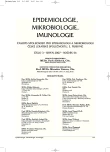Prion Diseases
Authors:
J. Smetana; M. Vacková; R. Chlíbek
Authors‘ workplace:
Univerzita obrany, Katedra epidemiologie Fakulty vojenského zdravotnictví v Hradci Králové
Published in:
Epidemiol. Mikrobiol. Imunol. 56, 2007, č. 3, s. 112-118
Overview
The group of prion diseases includes many diagnoses which have been long known. Nevertheless, the general awareness of these diseases increased substantially with the outbreaks of bovine spongiform encephalopathy (BSE) and the emergence of a new variant of Creutzfeldt-Jakob disease (nvCJD) at the close of the XXth century. Although major advances have been made in this field, further research is required to better understand these diseases. Many questions related e.g. to the accurate definition of the causative agent, pathogenesis, diagnosis and treatment still need to be addressed.
The aim of this article is to present the latest knowledge of the etiology and epidemiology of these diseases with a focus on BSE and nvCJD, including measures taken for their control.
Key words:
prion diseases – bovine spongiform encephalopathy – Creutzfeldt-Jakob disease – epidemiology.
Labels
Hygiene and epidemiology Medical virology Clinical microbiologyArticle was published in
Epidemiology, Microbiology, Immunology

2007 Issue 3
Most read in this issue
- Clinically Important β-Lactamases of Gram-Negative Bacteria: Extended-Spectrum β-Lactamases (ESBL)
- Prion Diseases
- Immunogenicity of Vaccines Against Viral Hepatitis A and B in the Population above 40 Years of Age – Impact of Risk Factors
- ABC Transporter Proteins in Multidrug Resistance of Microorganisms
